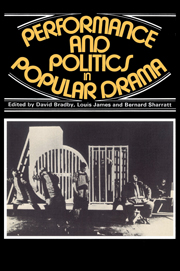 Performance and Politics in Popular Drama
Performance and Politics in Popular Drama Book contents
- Frontmatter
- Contents
- List of contributors
- Preface
- Acknowledgements
- PART ONE Spectacle, performance and audience in nineteenth-century theatre
- PART TWO Politics and performance in twentieth-century drama and film
- Introduction
- Meyerhold and Eisenstein
- Erwin Piscator's 1927 production of Hoppla, We're Alive
- Prolet Buehne: agit-prop in America
- Workers' theatre 1926–36
- The October Group and theatre under the Front Populaire
- Only the stars survive: disaster movies in the seventies
- PART THREE Problems and prospects
- Appendix: Tempo, Tempo
- Select bibliography
- General index
- Index of titles of plays, films, sketches
- Index of theatres, theatre companies and groups
Only the stars survive: disaster movies in the seventies
Published online by Cambridge University Press: 08 March 2010
- Frontmatter
- Contents
- List of contributors
- Preface
- Acknowledgements
- PART ONE Spectacle, performance and audience in nineteenth-century theatre
- PART TWO Politics and performance in twentieth-century drama and film
- Introduction
- Meyerhold and Eisenstein
- Erwin Piscator's 1927 production of Hoppla, We're Alive
- Prolet Buehne: agit-prop in America
- Workers' theatre 1926–36
- The October Group and theatre under the Front Populaire
- Only the stars survive: disaster movies in the seventies
- PART THREE Problems and prospects
- Appendix: Tempo, Tempo
- Select bibliography
- General index
- Index of titles of plays, films, sketches
- Index of theatres, theatre companies and groups
Summary
‘Disaster movies’ were a phenomenon of the early and mid 1970s, and for a time it looked as though they might prove an enduring feature of the world movie market: they had done extremely well at the box office in both the United States and Britain, and a definite cycle of films could be identified. The cycle, however, seems to have terminated early in 1977 with the second sequel, Airport ‘77, to the movie that apparently started it all at the beginning of the decade. Since then, there has been the occasional echo – in, for instance, the ill-fated Cassandra Crossing, some scaled-down TV movies (Flight to the Holocaust, Smash-up on Interstate Five), and a sequence or two in the otherwise straightforward thriller Roller coaster — but it is certainly no longer possible to speak, as it was in 1974—5, of a flourishing cycle of films. Disaster movies, in other words, are now a part of cultural history. Their narrative strategies and devices, on the other hand, are still very much current: they exemplify a trend in popular – or ‘dominant’ – cinema.
The term ‘disaster movie’ needs some definition: though never a true generic label like Western or Horror movie, it was nevertheless in fairly current use and endowed for a time with a definite if imprecise meaning by the cinema-going public. Someone going to see a disaster movie knew by and large what she or he was going to get.
- Type
- Chapter
- Information
- Performance and Politics in Popular DramaAspects of Popular Entertainment in Theatre, Film and Television, 1800–1976, pp. 243 - 270Publisher: Cambridge University PressPrint publication year: 1980
- 5
- Cited by
